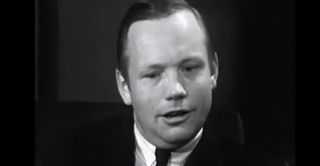
NASA Astronaut Neil Armstrong was the first man to set foot on the moon and became a national hero. Armstrong recently died at the age of 82, many years after he changed history. So how did a guy from Ohio bravely step onto the moon?
Armstrong was born Aug. 5, 1930 in Ohio. He studied aerospace engineering at Purdue University and became a naval aviator a couple years before the Korean War. He was accepted to the NASA Astronaut Corps in 1962 and flew for his first time as a command pilot on Project Gemini.
NASA had a lofty goal, to send a man to the moon and return him safely by the end of the 1960s. Armstrong was selected as the flight commander for Apollo 11 in the first manned mission to the moon.
When the capsule blasted off into on July 16, 1969, the crew of Apollo 11 set off to make one of the most historic voyages in space history. Apollo 11 touched down on the moon on July 20, 1969 and Armstrong was the first to climb down the ladder uttering the historic words, “That's one small step for [a] man, one giant leap for mankind." (There is controversy surrounding what Armstrong actually said.)
Armstrong and fellow Apollo 11 astronaut Buzz Aldrin spent nearly three hours exploring on the moon. The third crew member, Michael Collins, spent that time in lunar orbit until the two men returned.
The successful return of all three men was a big step in space exploration. Armstrong was awarded the Presidential Medal of Freedom, the Congressional Space Medal of Honor and the Congressional Gold Medal along with his former crewmates.
Armstrong went on to teach aviation science and served as chairman of Computing Technologies for Aviation, Inc. for some time. On Aug. 25, 2012, he passed away from complications in his coronary arteries.
Sign up for the Live Science daily newsletter now
Get the world’s most fascinating discoveries delivered straight to your inbox.
Follow Life's Little Mysteries @llmysteries. We're also on Facebook & Google+.
Most Popular



